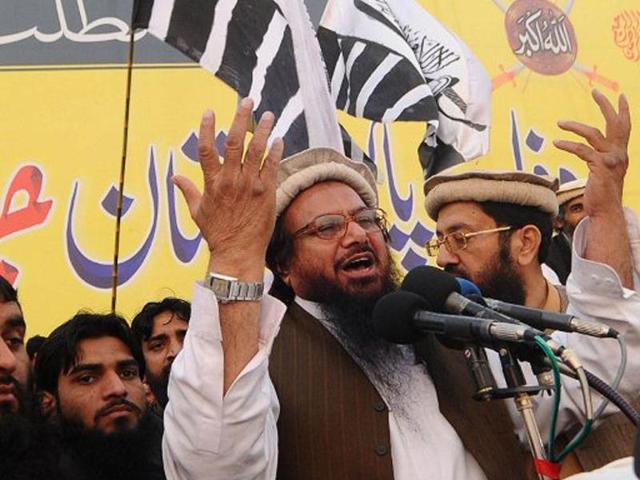Saeed's challenge: Catch me if you can
We know that Hafiz Saeed, suspected 26/11 mastermind, has one of the biggest bounties on his head. Shishir Gupta gives the inside story of how and why the US zeroed in on the terror financier as the world’s new Enemy No 1. Also wanted Pak-based terrorists involved in cases in India
Terrorism emanating from Pakistan was one of the talking points during three-and-a-half hour long delegation level talks between Indian Foreign Secretary Rajan Mathai and visiting US Under-Secretary of State for Political Affairs Wendy Sherman last April 2, 2012.


From the first meeting of Indo-US counter-terrorism group in February, 2000 when Washington still benignly viewed Pakistan-sponsored terrorism in India as part of moral political support for the Kashmir issue, to April 2 meeting where Pakistan’s perfidy over tackling terror was discussed in the open. However, what has foxed the Indian interlocutors is placement of Hafiz Saeed just next to Al Qaeda chief Ayman Al Zawahiri, who has got a bounty of US $25 million on his head. It is obvious that the threat from Hafiz Saeed is so serious that the US has put Lashkar Amir in the same dreaded category as Abu Du’a, Al Qaeda head in Iraq, and Yasin-Al Suri, Al Qaeda head of Iran, and Taliban Amir Mullah Omar. What has led to this fundamental change in the American thinking about LeT and its leaders Hafiz Saeed and Hafiz Makki, who for the record heads the foreign wing of the proscribed outfit? India first officially highlighted the role of Hafiz Saeed in its August 1, 2009 dossier to Pakistan demanding that Islamabad assist New Delhi in executing the non-bailable warrant against Hafiz Saeed for his role in 26/11 massacre. The dossier demanded that Hafiz Saeed should be arrested and questioned for his role in 26/11 by Indian enforcement agencies. The Indian charge was based on statement of sole surviving Lashkar 26/11 gunman Mohammed Ajmal Mohammed Amir Kasab, statement of CRPF Rampur Camp attack (January 1, 2008) accused Fahim Ansari and arrested Lashkar Nepal chief Sabahuddin. All three had shared their personal experiences and motivation with Hafiz Saeed including details of his involvement in 26/11 logistics, planning and attack.
The Indian document entitled “Dossiers on Pak Nationals involved in Mumbai Terror Attacks” handed over to Pakistan during Foreign Secretary level talks on February 25, 2010 also had Hafiz Saeed as India’s number one enemy but there was hardly any further substantiation from the previous document. So what changed the American mind on LeT that its chief patron had become enemy of mankind? Consider this:
Change of mind
In 2009, a highly classified briefing was given to Indian diplomats in Washington by officials linked with Senate Intelligence Committee. According to them, there was evidence to indicate that Lashkar terrorists, trained by Pakistan Special Forces, were operating in coordination with Taliban in eastern and southern Afghanistan and targeting American and ISAF troops.
After indictment of 11 LeT operatives in Virginia in 2003, this was the first sign showing that the group had global ambitions and wanted to target US apart from India. It is another matter that Nehchal Sandhu, then Joint Director (Operations) Intelligence Bureau, had shown his American counterparts in counter-terror working group in 2000 a seized Jamaat-ud-Dawwa diary that had listed In India, US and Israel as LeT’s primary targets.
In 2009-2010, arrested Lashkar terrorist and 26/11 accused American national of Pak origin David Coleman Headley gave a wealth of information about Hafiz Saeed and Makki’s involvement in 26/11 attacks. Headley told his Indian interrogators in June 2010 that “every major action of LeT is done only after the approval of Hafiz Saeed” and that 26/11 Mumbai attacks could not have been possible without support of Pakistani ISI. “Hafiz Saeed had full knowledge of Mumbai attacks and it was launched only after his approval,” Headley said while baring the close linkages that LeT had with ISI with every important member of the terrorist group being handled by one or more ISI officials.
More proof
In 2010, US and Indian Intelligence got credible reports that ISI was using Saeed as a conduit to the Haqqani network in Afghanistan to give the Pak agency a degree of deniability with the Americans.
Post US withdrawal from Afghanistan, Saeed’s role will become indispensable to ISI and other prominent political families of Punjab. Saeed is not only toast of Corps Commanders of Pakistan Army but was personal friends with political families of Pakistan. His only enemy was Tehrik-e-Taliban Pakistan, which had tried to unsuccessfully assassinate him in a fidayeen attack in 2010.
It is evident from above that Lashkar is now a global threat with its cadre trained by professional Pakistan soldiers in war making and subversion. With Pakistani ISI treating LeT as its strategic arm, the price on Saeed’s head had to be humongous.
While Saeed and Pak establishment may make light of American bounty on his head, both will have trouble in sleeping in the future as Washington is just keeping quiet. It was only a year ago, that US violated Pakistani sovereignty and its military bravado by taking out Osama bin Laden from an ISI safe house in Abbotabad Military Cantonment.





